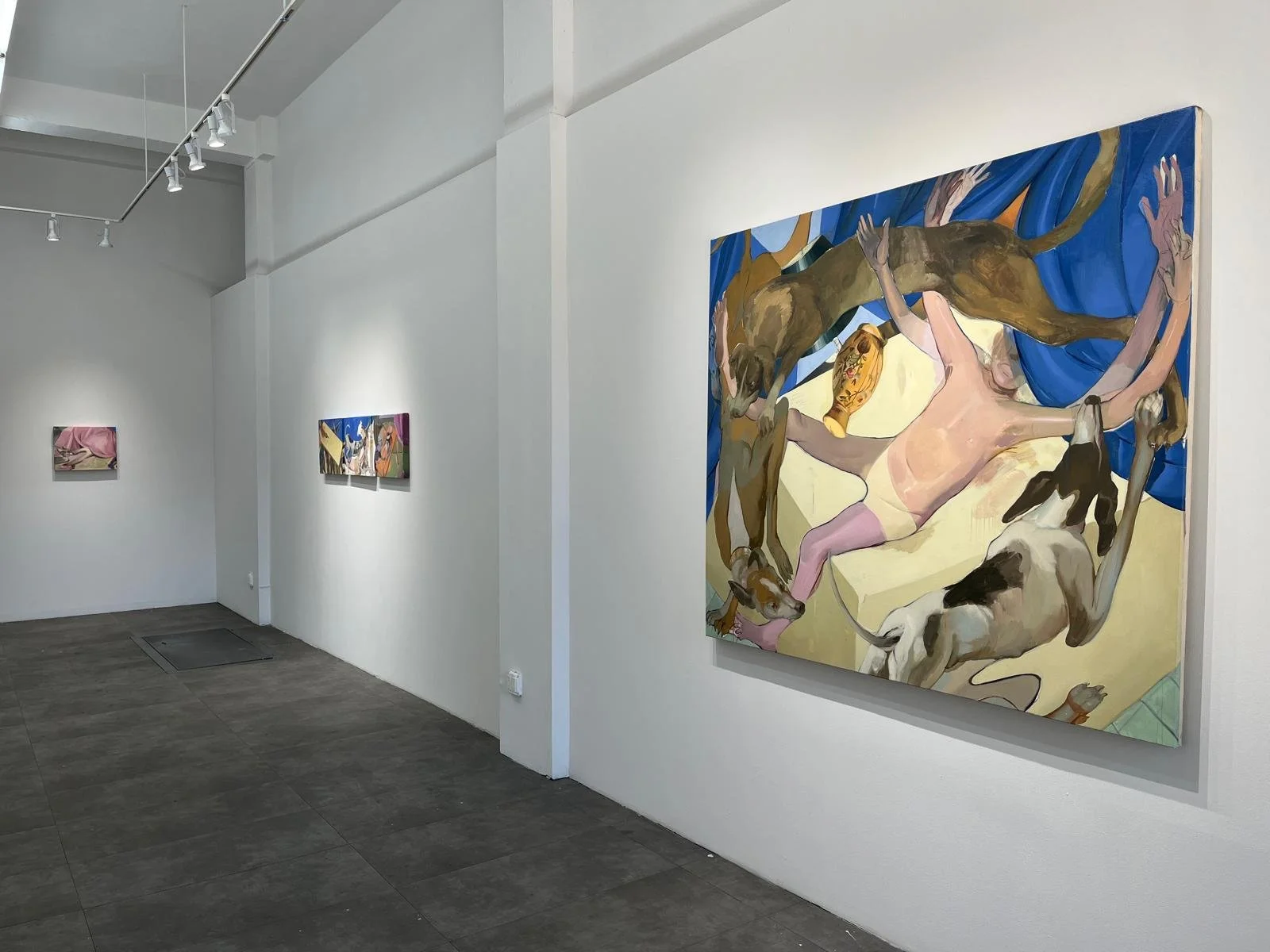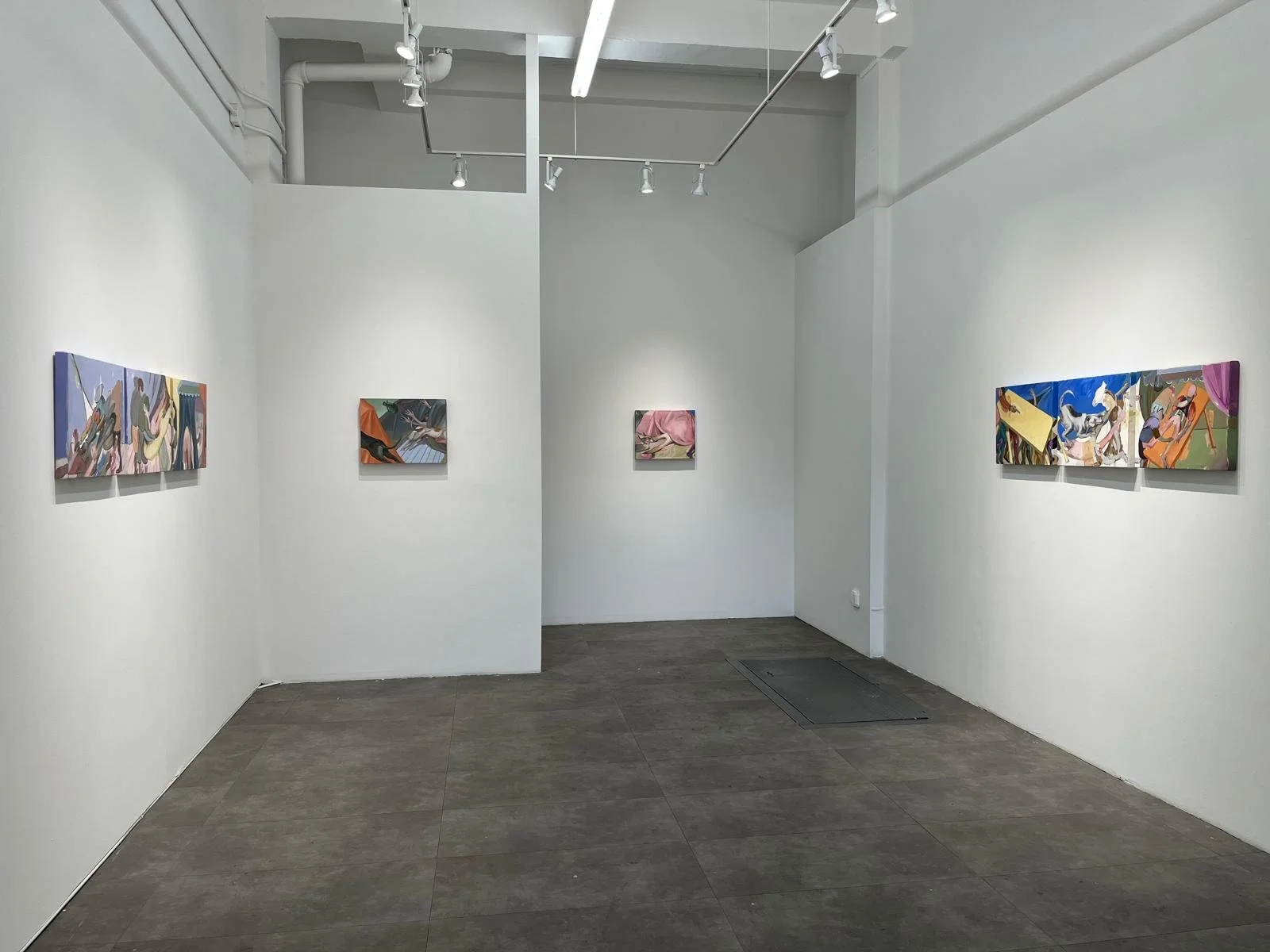Hot Coffee with Gonzalo Garcia, Mexico City-based artist who paints intimacy and violence
Published Monday,April 21,2025
I met Gonzalo Garcia for the first time digitally in 2024 through his works on social media, while thinking of the artists for the (then) upcoming show in Berlin. His works were disturbing and yet gentle. Was I looking at the scenes of torture? Was there a point in showing these vivisections? Over time, as we started a conversation and worked on the show, I got responses to my questions. Torture, we see, is symbolic and realistic simultaneously; it is rooted in the Mexican protests of the 1960s culminating in the Tlatelolco massacre of 1968 and the artistic traditions responding to this national trauma. In the ongoing show Interlace at Kates-Ferri Projects, New York, presented in collaboration with CAM Gallery, Mexico, and curated by Charles Moore, Gonzalo Garcia continues with these transliterations of the past. Garcia’s scenes are often intimate, yet nearly always have hidden or overt signs of power plays. I wanted to ask Gonzalo several questions about this.
Nina: Imagine you are in your favorite coffee or tea spot. Where is it? What are you drinking? What are the three things you see right now?
Gonzalo: My favorite café exists only in my imagination, but it would be somewhere in downtown Mexico City, on a street like Donceles or 16 de Septiembre. It's a rustic place with comfortable, cushioned furniture in dark green or ashy red tones. I’m drinking mint tea with honey from a ceramic teapot, and I see a carved wooden oval table on which I’m serving my tea. I also see my sketchbook and a case of colored markers, and I see hanging on the wall in front of me a lithograph of a piece by Edvard Munch.
Installation image of Interlace: Gonzalo Garcia at Kates-Ferri Projects, April 1-May 10, 2025.Image courtesy of the artist and the gallery.
Installation image of Interlace: Gonzalo Garcia at Kates-Ferri Projects, April 1-May 10, 2025. Image courtesy of the artist and the gallery.
Nina: Please tell me more about the works in your new solo show that opened this week in New York, titled 'Interlace.' What is the central theme of these works, and what place do these works occupy in your practice?
Gonzalo: The series of paintings I’m currently exhibiting at Kates-Ferri Projects gallery in New York is inspired by a Mexican film from the 1970s titled “Los Cachorros” (The Cubs) by Mexican director Jorge Fons. This series is part of a larger research project I’ve been developing for over four years, where I aim to establish a conversation between Mexican cinema of the 1970s and contemporary painting. The reason is that the cinema of this era is loaded with social and cultural issues that interest me and that we still experience and suffer from as a country. Issues such as gender violence, machismo, homophobia, and the body as a political subject are themes that these films share with my paintings.
Specifically, this film by Fons, Los Cachorros, tells the story of a young boy who, after an accident at school, is attacked by a wild dog while showering in the school bathrooms, resulting in his castration by the dog. For a country like Mexico, a film like this is highly unusual, and it became the trigger for me to start thinking about this new body of work inspired by themes surrounding the male body through the lens of castration. These are themes I relate to as a homosexual artist, such as violence, discrimination, eroticism, masculine fragility, the medieval era, and the concept of "delirium" approached through psychoanalysis, which helps explain the theatricality of these images. Texts by authors like Paul B. Preciado, Byung-Chul Han, and Sigmund Freud began to contaminate my imagination while I was creating these paintings.
Gonzalo Garcia: Inclusion I, 2025, Oil on canvas, 9.8 x 13.7 inches. Photo courtesy of the artist.
Nina: You have worked with many different curators recently, including our collaboration on Trust Issues at Kornfeld Galerie in Berlin this spring. What do you think is the value of collaborations between artists and their curators? What could be the drawbacks?
Gonzalo: I think from my experience with you, Nina, and other curators like Charles Moore—who curated Interlace at KatesFerri Projects—or the Mexican curator Victor Esquivel, who worked very closely with me in developing this particular series of paintings, I’ve come to understand the incredibly enriching exchange that occurs when you place your work as an artist in conversation with the background and experience of curators, who can offer new perspectives on your processes. From the formal aspects to the conceptual core of my painting, you and I, dear Nina, have discussed many filmmakers and philosophers surrounding the work, and beyond contributing ideas to the show we’re currently collaborating on, those insights will be useful for my future studio practice. I believe it’s a wonderful exchange—a continuous conversation in which I have the opportunity to nourish your curatorial vision from my perspective as a contemporary artist, while at the same time, you offer me new starting points to rethink and execute my work.
Gonzalo Garcia: Pitched battle VI (the fordist table) 2025, Oil on canvas, 15.7 x 19.6 inches. Photo courtesy of the artist.
Gonzalo Garcia: Pitched battle V (the tent) 2025, Oil on canvas, 15.7 x 19.6 inches. Photo courtesy of the artist.
Nina: I know that many of your works have been inspired by cinematic experiences. What is the first film that made the biggest impact on you and why? What is the most recent film that made an impact on you?
Gonzalo: Definitely one of the films that has had the biggest impact on me is Los Cachorros, and another one you know well and which has also inspired much of my recent work is El Castillo de la Pureza (The Castle of Purity) by Arturo Ripstein. But to avoid repeating myself, I’ll tell you about another film from that same decade that has deeply disturbed me—and one I couldn’t bring myself to paint anything about—titled Canoa by director Felipe Cazals. The story is about five young men from the city of Puebla (which is where I’m originally from) who decide to go camping and climb a volcano for the weekend. Halfway there, they are forced to spend the night in a small rural town called Canoa. The story takes place during the student protests against the Mexican government in 1968, one of the most significant social movements in our country’s history. Due to mass psychosis, the villagers come to believe that the young men are part of the student movement (which they are not), and the film ends with the townspeople brutally massacring them. The final scene is so brutal that it leaves a void in your stomach—and that feeling only intensifies when you realize the film is based on real events. I simply couldn’t paint that.
Gonzalo Garcia: Pitched battle VII (the dogs and the vase) 2025, Oil on canvas, 15.7 x 19.6 inches.Photo courtesy of the artist.
Gonzalo Garcia: Pitched battle IV (the dogs) 2025, Oil on canvas, 15.7 x 19.6 inches.Photo courtesy of the artist.
Nina: The Mexican art scene is experiencing a boom or so it seems from the outside. How do you think this influences contemporary artists - do you believe it pushes them to self-exoticism in some way? This happened in Eastern Europe quite a bit and I was wondering how it feels from the perspective of a Mexican artist.
Gonzalo: I think that’s the million-dollar question. I’m convinced the Mexican art scene is booming, and it’s full of incredible artists with complex and deep processes that reflect our contemporary societal issues. I’m very glad to be part of this historic moment in contemporary art in my country. However, I do believe the risk of self-exoticism you mention—and other risks—are real. I think we Mexican artists have a great responsibility to be even more ethical in the narratives we create and how we represent them through our chosen mediums, whether it be painting, photography, sculpture, installation, or digital media. The way we take responsibility now for these works of art will define the path for new generations of Latin American artists, who will increasingly become part of the global conversation (which is so urgently needed right now)—not only in contemporary art, but in the broader context of the times we’re living through as a humanity.







